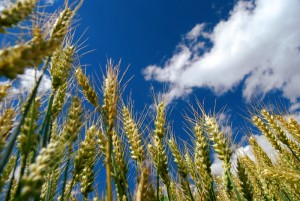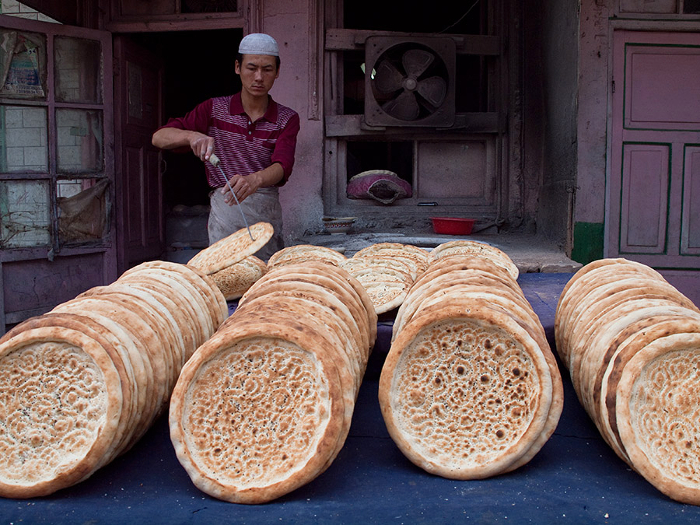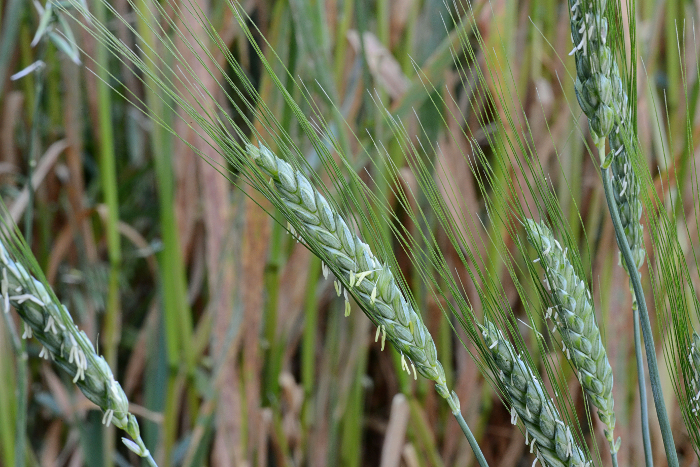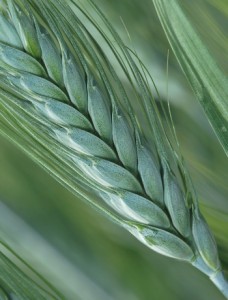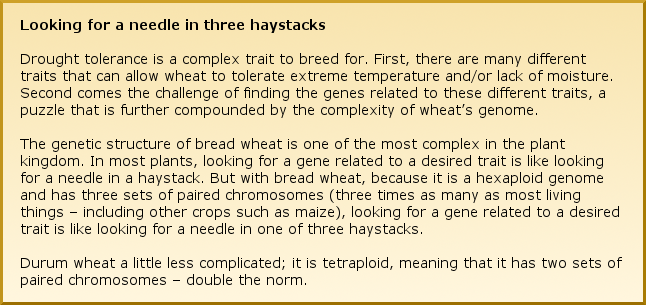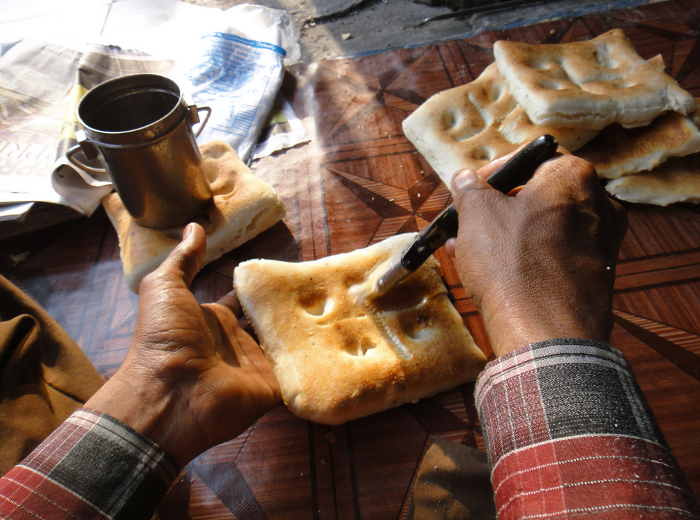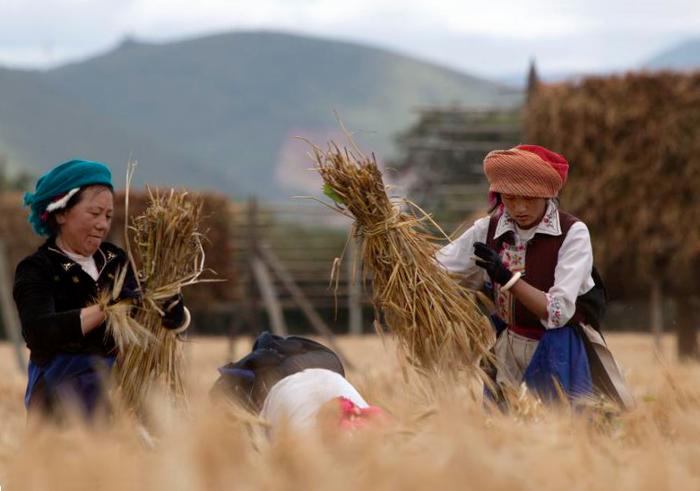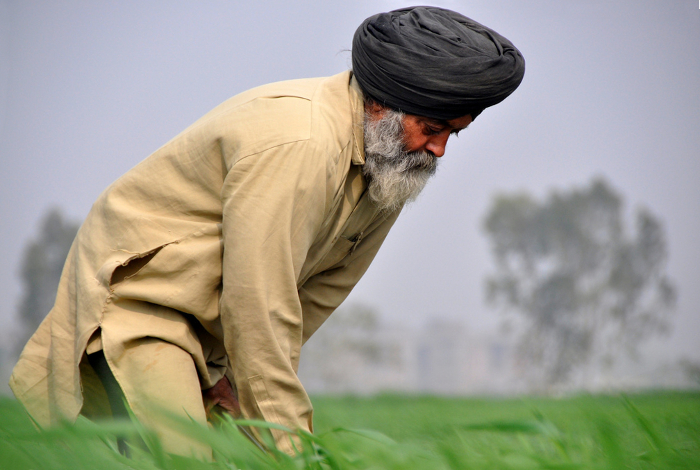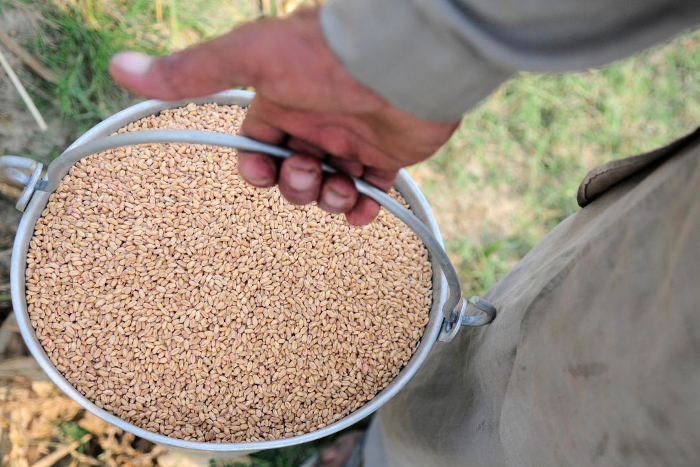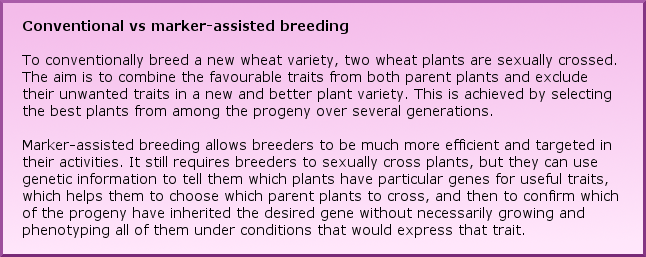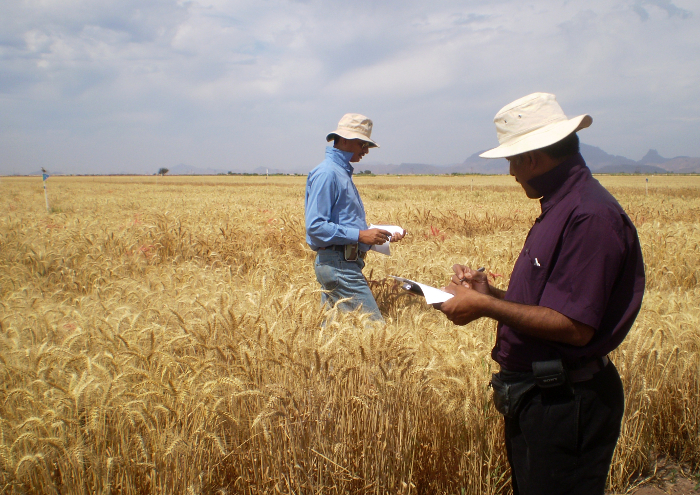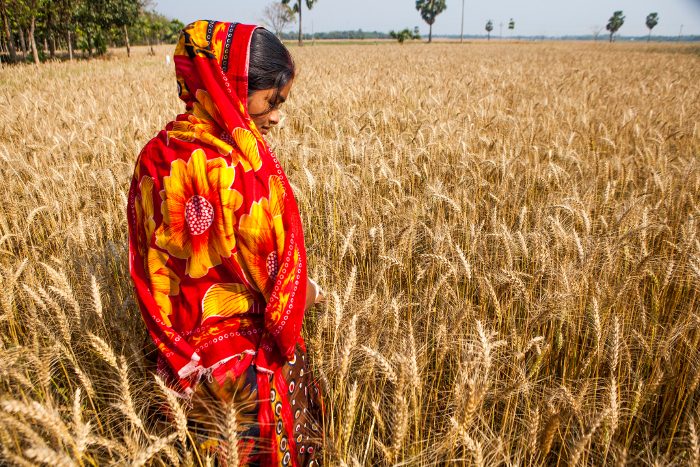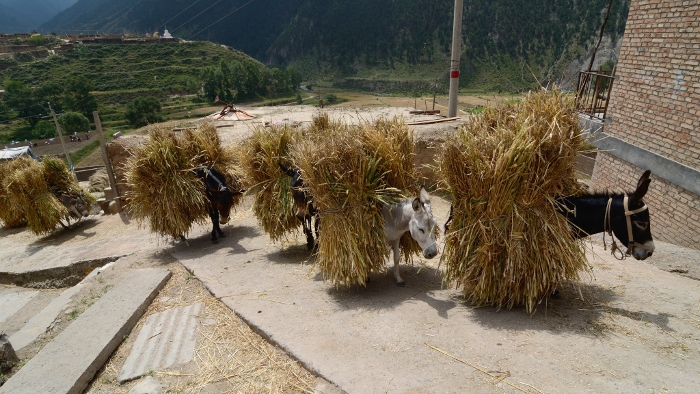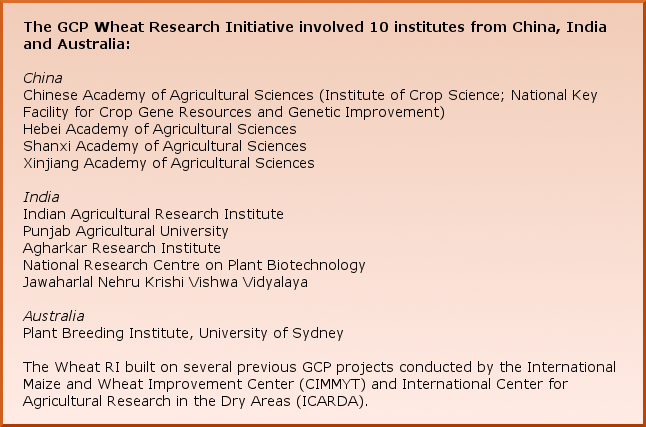For as long as peoples and countries have traded wheat, drought has continually played a part in dictating its availability and price. Developed countries have become more able to accommodate the bad years by using intensive agricultural practices to grow and store more wheat during more favourable years. However, farmers, traders and consumers are still at the mercy of drought when it comes to wheat availability and prices.
A recent example where drought in just one country inflated the world’s wheat prices was in the People’s Republic of China during 2010–11.
For almost six months, eight provinces in the north of China received little to no rain. Known as the breadbasket of China, these eight provinces grow more than 80 percent of the country’s total wheat and collectively produce more wheat than anywhere else in the world.
It was the worst drought to hit the provinces in 60 years.
With over 1.3 billion mouths to feed, China’s demand for wheat is high and ever increasing. When this demand was coupled with the reduced wheat yield caused by the severe 2010–11 drought, wheat prices around the world rose. While this price rise was beneficial for wheat growers in other countries, it made wheat unaffordable for many consumers and traders in developing nations.
Although this was a one-in-60-year event, previous droughts had already made locals question the sustainability of wheat production in this naturally dry region of China, where water consumption has increased in the past 50 years due to intensive agriculture, industry and a growing and increasingly urbanised population.
Wheat growers and breeders know they need to find wheat varieties and apply practices that will help them adapt to and tolerate drier conditions and still produce sustainable yields.
Luckily, they have help from a community of breeders around the world.
Sharing knowledge to improve breeding efficiency and sustainability
In March 2009, 70 international plant breeding leaders and experts from the public and private sector converged in Montpellier, France, as part of a CGIAR Generation Challenge Programme (GCP) initiative to draw up roadmaps to improve plant-breeding efficiency in developing countries.
Richard Trethowan, professor in plant breeding at the University of Sydney, Australia, remembers the meeting distinctly. “We all got together and thought how we could use what we had learnt during the first phase of GCP [2004–2009] – all the genetics and molecular-breeding work – to deliver new varieties of crops, particularly in countries where it will have the greatest impact.”
The resulting roadmap for wheat became the GCP Wheat Research Initiative (RI), with Richard as Product Delivery Coordinator. It had two very clear destinations in mind: China and India.
Richard explains why China and India were targeted – as the world’s two wheat-production giants – in the video below.
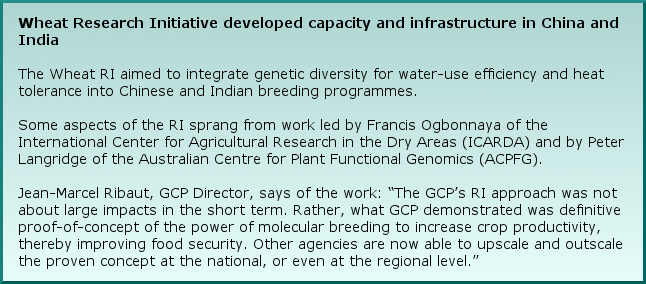
Like China, India is an extremely water-stressed country, with the water table in many places falling at an alarming rate. In North Gujarat alone, an established wheat district in western India, the water table is reported to be dropping by as much as six metres per year.
Delivering wheat varieties that have improved water-use efficiency and higher tolerance to drought will have the greatest impact in these countries, given they are the two largest producers of wheat worldwide.
“Even though the Initiative is set to conclude in 2015, the outcomes have already been absolutely phenomenal for such a short time-bound project, given that wheat is such a complex plant to work with,” exclaims Richard. “While we are still a few years away from releasing new drought-tolerant varieties, we have been able to develop systems and build capacity to reduce the time it takes to develop and release these varieties.”
Tapping into genetic diversity to enhance wheat’s drought and heat tolerance
One project that impressed Richard was that led by Satish Misra, GCP Principal Investigator and senior wheat breeder at Agharkar Research Institute, Pune, India.
In a collaboration with the University of Sydney, Australia, and the International Maize and Wheat Improvement Center (CIMMYT), the project identified novel genes associated with drought- and heat-tolerance traits in ancestral wheat lines (of emmer wheat).
Emmer wheat is a minor crop grown mainly in marginal lands, where farmers can produce a small harvest but nowhere near the yield of more elite cultivated lines. Satish explains that emmer wheat lines are very useful for breeders because they have a larger diversity of novel genes than more popular wheat types, such as durum or bread wheat.
“Durum lines are more commonly used by breeders because of their high yield and hard grain, which is used to make bread wheat and pasta,” Satish says. “However, because of their popularity and continual use in breeding, durum wheat lines have become less and less diverse with years of cultivation.”
The first task was to identify emmer lines that might have genes for drought and heat tolerance. Satish says that CIMMYT played an important part in this process. “They gave us access to their gene bank, which contains almost 2,000 emmer lines. More importantly, they helped us develop a reference set that encapsulated all the diversity found in the emmer lines they had.”
A reference set reduces the number of choices that breeders have to search through, from thousands down to a few hundred – in this case, 300 emmer lines.
“CIMMYT also developed 30 synthetic emmer wheat lines by crossing wild emmer wheat species with domesticated wheat species,” says Satish. “The synthetic lines contain the novel drought- and heat-tolerance genes.”
Satish and Richard’s teams crossed these synthetic lines with durum wheat lines and identified 41 resulting lines with high levels of stress tolerance. These are undergoing further evaluation in India and Australia.
“What Satish has been able to do in five years is amazing and is currently having a big impact in wheat breeding in India and Australia,” says Richard. “We’ve had local breeding companies here in Australia come to us requesting the lines we developed. The same is happening in India, too.”
Reaping existing skills
For Richard, the preliminary success of the Wheat RI is due, at least in part, to the speed with which national breeding programmes in both China and India are learning and incorporating new molecular-breeding techniques.
“This was another reason why we chose to focus on China and India: they had the infrastructure and human capacity to start doing this almost immediately,” says Richard. “In other countries where GCP is investing, more time is going into teaching breeders the basics of molecular breeding and genetics. In China and India, they already have that basic understanding and are able to quickly incorporate it into their current programmes.”
This does not mean, however, that the work is not focused on building capacity, given that molecular breeding is still a relatively new concept for many breeders around the world.
Ruilian Jing says the China project is continually working to educate and train wheat breeders in molecular-breeding techniques.
“When we started the project, we found that most institutions that focus on wheat breeding in China had the equipment to do marker-assisted breeding but were unsure how to use it,” says Ruilian, professor in plant breeding at the Chinese Academy of Agricultural Sciences (CAAS) and Principal Investigator for the Wheat RI’s drought-tolerant wheat project in China.
Much of Ruilian’s work in China has been in educating these breeders so they can start achieving outcomes.
Younger researchers taking a lead
Ruilian explains that those leading the charge to become educated in molecular-breeding techniques are young researchers, including seven PhD students and one Master’s student supported by the project in China.
One such researcher who is enthusiastically applying these new approaches is Yonggui Xiao, a molecular plant breeder at the Institute of Crop Science, CAAS.
“Working as part of this GCP project gave me my first opportunity to practice using molecular-breeding techniques to improve the quality and yield of wheat under drought conditions,” says Yonggui.
“We have so far successfully used several molecular markers to produce an advanced variety, with higher yield and preferred qualities [taste, grain colour] under water stress, and this will be released to farmers [in 2015].”
Yonggui is now expanding the application of the technology to develop varieties with resistance to powdery mildew, a fungal disease that can reduce wheat yields and quality during non-drought years. “Overall, we have been impressed by how these new techniques complement our conventional breeding techniques to improve selection efficiency, in turn reducing the time and costs of producing advanced varieties,” says Yonggui.
Success stories like these make Ruilian’s job easier as she tries to encourage more and more plant breeders to experiment with these new breeding techniques.
At the same time, she is impressed by this new generation of molecular wheat breeders who will ensure that these techniques benefit wheat research in many years to come: “This form of capacity, the human capacity, which we are building, is what will leave the largest legacy in China and help this technology spread from generation to generation and crop to crop.”
Overcoming complex traits, genes and wary breeders
Across the Himalayas, Ruilian’s Indian counterpart, Vinod Prabhu, is just as pleased with the progress and results his team are producing.
“Over the last five years, we have discovered several water-use efficiency traits and their related genes, bred new lines to incorporate the genes and traits and run national trials, all of which would be unheard of using only conventional breeding practices,” says Vinod, Head of the Genetics Division at the Indian Agricultural Research Institute in New Delhi and the Principal Investigator for the Wheat RI’s drought-tolerant wheat project in India.
By the end of the projects in November 2015, partners in China and India will deliver 15–20 new wheat lines with drought and heat tolerance, adapted to each country’s conditions. An additional target for both China and India is to produce four wheat varieties with improved water-use efficiency and higher heat tolerance. These varieties will have the potential to cover about 24 million hectares and minimise yield loss from heat or drought, or both, by up to 20–50 percent.
Vinod confides that all these outcomes are far more than what he initially expected they would achieve: “When we started, we had a lot of reservations about the complexity of breeding for drought tolerance in wheat as well as the acceptance and uptake of these new breeding techniques by conventional breeders.”
Vinod’s primary role has been to coordinate the Indian centres working on the project (see box at end). But he has also been working to convince Indian plant breeders that these unconventional, new breeding techniques will improve their efficiency and aid in their quest to breed for heat- and drought-tolerant wheat varieties.
“Many world-leading wheat breeders were wary at first, but they have definitely started to see the merit in using the technology to enhance their conventional methods as we edge closer towards releasing new varieties in such a short time,” says Vinod.
Incorporating conventional methods
An aspect of the Wheat RI that Ruilian and Vinod have been continually promoting is the importance of conventional breeding methods. “These new molecular-breeding techniques are only a small part of the whole breeding process,” says Ruilian. “Yes, they provide a big impact, but in the grand scheme of things they need to be viewed as one tool in a breeder’s tool box.”
For more information on conventional versus molecular breeding, or marker-assisted breeding, see our quick guide here on the Sunset Blog.
Phenotyping: How to manage a subjective process
One of the most important processes of the Wheat RI, and plant breeding in general, is phenotyping: measuring and recording observable characteristics of the plant such as drought tolerance or susceptibility to pests and diseases. Breeders phenotype the plants they have developed to see which ones have the traits they are interested in and also – for molecular breeding to be possible – to establish links between specific genes and specific traits.
Unfortunately, phenotyping has caused a bit of trouble for both Chinese and Indian partners. The challenge stems from the fact that one person’s observations about a plant’s phenotype or characteristics may not be the same as another person’s.
“This is always a challenge for any collaborative plant-breeding project,” says Vinod. “Unless all trials are inspected by one person, there will always be a risk of inconsistent observations.
To help overcome this inconsistency, one of the first activities of the Wheat RI was to develop phenotyping protocols that allowed researchers in different research institutes and countries to collect comparable data. GCP enlisted Matthew Reynolds, a wheat physiologist at CIMMYT, to help with this.
“Each breeder has their own ways to do things, so it’s important to develop standardised protocols, particularly for a transnational project like this,” explains Matthew. “We developed a few standardised phenotyping manuals and travelled to China to give some intensive hands-on training.”
This problem is not unique to China and India. Another GCP wheat project is providing promising results to help overcome the risk of inconsistency and increase the efficiency and accuracy of phenotyping. Led by Fernanda Dreccer, based at Australia’s Commonwealth Scientific and Industrial Research Organisation (CSIRO), in collaboration with the International Center for Agricultural Research in the Dry Areas (ICARDA), the project is developing a reliable phenotyping approach to detect drought-adaptive traits in wheat crops using cheap and simple tools.
“For example, using just a camera you can analyse crop cover, which is an important trait for shading the crop and/or trapping heat,” says Fernanda. “The idea was to test different non-invasive, low-cost tools and compare them to find something that would provide accurate and useful data related to identifying drought-tolerance traits.”
Another important aspect of phenotyping that Fernanda’s project is helping with is constant and consistent analysis of a crop’s surroundings. “It’s just as important to measure the environment of the crop as it is [to measure] the crop itself to make a correlation between an environmental impact and a plant’s reaction,” says Fernanda.
Since the static nature of single observations can give a misleading or incomplete picture, Fernanda’s team is integrating live crop, weather and soil data through mobile sensors in the field with the aim of producing constant phenotypic information. “This will provide new insights into the interaction between the genotype and the environment. This in turn will help to accelerate the detection of wheat genotypes better suited to cope with drought.”
Managing the tsunami of phenotyping data
Although a plant breeder’s work should be simplified and made more efficient by combining molecular-breeding technologies with advanced phenotyping techniques and protocols, the reality is not necessarily so easy.
There are many steps to the plant-breeding puzzle, all of which produce data. The more advanced the techniques and – in the case of wheat – the more complex the plant’s genome, the more pieces of data breeders need to sift through to find solutions.
Before the Wheat RI started, Richard saw that this impending tsunami of data was going to be a problem in both China and India: “Both countries had the skills to carry out these advanced techniques, but they didn’t have in place a strong culture of data management.”
This problem is by no means unique to China and India, Richard says: “Most of the time, plant breeders keep a log of all their data in a book or Excel sheet. However, these data often get lost once a project is completed.”
GCP recognised this problem before the RIs began and has, since 2009, been developing the Breeding Management System (BMS) – a suite of interconnected software designed to manage the mass of data – as part of its Integrated Breeding Platform (IBP).
“The BMS is the first tool that can help breeders record and collate their data in a coordinated way,” says Richard. “This is vital in a project like this, which has several institutes across three countries working towards a similar product.”
Vinod agrees with Richard, adding that the BMS was relatively easy for his Indian partners to learn and use: “The BMS is great as we have no way of losing data.”
Rolling out the BMS in China, though, has been more difficult due to the language barrier. Ruilian explains: “We are now working towards translating the IBP, but it will be an ongoing challenge as the platform continually changes and is updated.”
Ruilian is optimistic that a translated BMS will become a viable tool for Chinese breeders in the future. “The more that we collaborate with other countries, the more a tool like this becomes important to have.”
Watch Richard on adoption of IBP tools in the video below.
Friendly competition helping inspire India’s wheat breeders
Vinod credits two things for the successful development of new wheat varieties and integration of new breeding techniques and data-management systems: a clear, logical plan and friendly competition between China and India to breed the first new drought-tolerant varieties.
“The initial plan, which Richard helped develop in Montpellier, was logical and well thought out. Although we initially thought it was overambitious in its objectives, we have been able to meet them so far, which is a great credit to the team and their enthusiasm to try these new technologies and see for themselves the benefits first hand.
“What has also helped is our competitive spirit, as we would like to achieve the objectives before the Chinese breeders do. Our breeders are always asking me for updates on how China is progressing!” Vinod adds, with a chuckle.
Ruilian agrees with Vinod’s assessment, adding: “The project would not have been as successful if it was solely national. It needed the international collaboration and friendly competition to help build confidence and drive.”
For Richard this international collaboration, between two very different and proud cultures, allowed the project to broaden its scope and troubleshoot quicker than usual.
“They [the Chinese and Indian researchers] think about problems in different ways. When you get a group of people in a room from different backgrounds, you can come up with great integrated plans, things you would never have come up with within just a national team,” says Richard.
Watch Richard on the beauty of diversity in research partnerships in the video below.
Securing wheat production into the future
With the project concluding in 2015, both the Chinese and Indian researchers are working towards completing national trials and releasing their new, advanced drought-tolerant varieties to farmers and other breeders. However, for Richard, the impact of the Wheat RI may not be fully recognised for 10–20 years.
“The initial new varieties that both China and India develop will help farmers in the short term. However, as both countries become more advanced in using the technology, future varieties are sure to be more and more robust. What’s more, these techniques and tools are sure to filter through to other national wheat-breeding programmes, as well as to other crops.”
In the case of wheat, new drought-tolerant varieties will help secure both China’s and India’s wheat industries, helping to stabilise wheat yields, and consequently prices, the world over. These new varieties may not be the silver bullet for eliminating the risks of drought, but they will go a long way to mitigating its impact.
More links
- Wheat Research Initiative | InfoCentre | slides (on SlideShare)
- Watch our full series of short Q&A on wheat research with Richard Trethowan on YouTube








